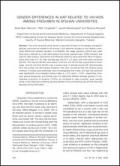Publications - Released in 2008
This cross-sectional study aimed to describe the level of knowledge, perception/attitude, and practices related to HIV among 1,054 freshmen students in four Afghan universities differences between genders. A probability, two stage sampling method was used. Data were collected by a self administered structured questionnaire. SPSS software was used for data analysis. Descriptive and inferential statistics were performed. Most of respondents were male (72.1%), their average age was 20.1 ± 2 years, and most were unmarried (93.4%). The majority (90.8%) were aware of HIV but only 28.3% had a good level of knowledge. Around one-third (35.6%) had a positive level of attitude toward HIV. Approximately 30% had at least one risk practice; therefore, they were counted as high-risk behavior group members. Females were statistically more knowledgeable than males, and high-risk behaviors were significantly more prevalent among males; p = 0.01 and p = 0.001, respectively. However, general awareness, and attitude were not statistically different between genders. A considerable proportion of students (14.6%), as compared to peer-countries, were sexually active. A very high level of sharing injecting needles (4.5%) and shaving sets (20.8%) were also reported among informants.






